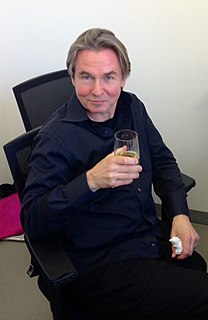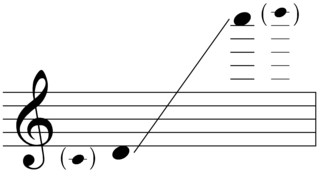
Esa-Pekka Salonen is a Finnish orchestral conductor and composer. He is principal conductor and artistic advisor of the Philharmonia Orchestra in London, conductor laureate of the Los Angeles Philharmonic, and music director-designate of the San Francisco Symphony.
Nyx is a symphonic poem by the Finnish composer Esa-Pekka Salonen. The work was jointly commissioned by Radio France, the Barbican Centre, the Atlanta Symphony Orchestra, Carnegie Hall, and the Finnish Broadcasting Company. It was premiered February 19, 2011 in the Théâtre du Châtelet, Paris, with Salonen conducting the Orchestre Philharmonique de Radio France. The piece is titled after the Goddess Nyx from Greek mythology.
The Asko Concerto is a concerto for chamber orchestra by the American composer Elliott Carter. The work was commissioned by the Dutch chamber group Asko Ensemble, for which the piece is titled. It was composed in January 2000 and was first performed in Concertgebouw, Amsterdam on April 26, 2000, by the Asko ensemble under the conductor Oliver Knussen. The piece is dedicated to Asko/Schönberg.
The Piano Concerto No. 2 is a composition for solo piano and orchestra by the Finnish composer Magnus Lindberg. The work was jointly commissioned by the Royal Concertgebouw Orchestra, the Gothenburg Symphony Orchestra, and the New York Philharmonic, for which Lindberg was then composer-in-residence. It was given its world premiere at Avery Fisher Hall on May 3, 2012 by the pianist Yefim Bronfman and the New York Philharmonic under the direction of Alan Gilbert.
The Violin Concerto No. 1 is a composition for solo violin and orchestra by the Finnish composer Magnus Lindberg. The work was commissioned by the Mostly Mozart Festival and was composed in 2006. It was given its world premiere at Avery Fisher Hall on August 22, 2006 by the violinist Lisa Batiashvili and the Mostly Mozart Festival Orchestra under the direction of Louis Langrée.
The Clarinet Concerto is a composition for solo clarinet and orchestra by the Finnish composer Magnus Lindberg. It was written for the Finnish clarinetist Kari Kriikku. The piece was given its world premiere in Finlandia Hall, Helsinki, on September 14, 2002 by Kari Kriikku and the Finnish Radio Symphony Orchestra under the direction of Jukka-Pekka Saraste. The composition is one of Lindberg's most frequently performed works.
The Cello Concerto No. 2 is the second cello concerto by the Finnish composer Magnus Lindberg. It was commissioned by the Los Angeles Philharmonic in June 2013 to fill the planned premiere date of Oliver Knussen's then delayed Cello Concerto. The work was first performed in the Walt Disney Concert Hall, Los Angeles, on October 18, 2013 by the Finnish cellist Anssi Karttunen and the Los Angeles Philharmonic under the direction of Esa-Pekka Salonen.
Souvenir is a composition for chamber orchestra by the Finnish composer Magnus Lindberg. The work was commissioned by the New York Philharmonic, for which Lindberg was then composer-in-residence. It was given its world premiere on November 19, 2010 at Symphony Space, New York City, by the New York Philharmonic under the direction of Alan Gilbert. The piece was written in memoriam for Lindberg's friend and fellow composer Gérard Grisey.
The Concerto for Orchestra is an orchestral composition by the Finnish composer Magnus Lindberg. The work was commissioned by the BBC and was composed between 2002 and 2003. It was given its world premiere by the BBC Symphony Orchestra under the direction of Jukka-Pekka Saraste on September 30, 2003 at the Barbican Centre, London.
The Concerto for Cello and Orchestra is a cello concerto by the Polish composer Witold Lutosławski. The work was commissioned by the Royal Philharmonic Society with support from the Calouste Gulbenkian Foundation. It received its world premiere at the Royal Festival Hall on October 14, 1970 by the cellist Mstislav Rostropovich and the Bournemouth Symphony Orchestra under the direction of Edward Downes.
The Cello Concerto No. 1 is a composition for solo cello and orchestra by the Finnish composer Magnus Lindberg. It was first performed in the Cité de la Musique, Paris on May 6, 1999 by the cellist Anssi Karttunen and the Orchestre de Paris under the direction of Esa-Pekka Salonen.
Kraft is a composition for solo ensemble, electronics, and orchestra by the Finnish composer Magnus Lindberg. The work was commissioned by the Helsinki Festival and was first performed on September 4, 1985 by the Toimii ensemble and the Finnish Radio Symphony Orchestra under the direction of Esa-Pekka Salonen. The piece was awarded the International Rostrum of Composers in 1986 and won the Nordic Council Music Prize in 1988.
The Piano Concerto No. 1 is a composition for solo piano and orchestra by the American composer Peter Lieberson. The work was commissioned by the Boston Symphony Orchestra for its centennial. Lieberson started composing the piece in 1980 and completed it on March 2, 1983. It was written for the pianist Peter Serkin, who first performed the concerto with the Boston Symphony Orchestra under the direction of Seiji Ozawa on April 21, 1983. The piece is dedicated to Peter Serkin and Seiji Ozawa. It was a finalist for the 1984 Pulitzer Prize for Music.
Fresco is an orchestral composition by the Finnish composer Magnus Lindberg. The work was commissioned by the Los Angeles Philharmonic. Its world premiere was given in Los Angeles on March 12, 1998 by the Los Angeles Philharmonic under the direction of Esa-Pekka Salonen, to whom the piece is dedicated.
The World's Ransoming is a concerto for cor anglais and orchestra by the Scottish composer James MacMillan. It was the first of three interrelated compositions in MacMillan's Easter triptych Triduum commissioned by the London Symphony Orchestra. Its world premiere was given by the soloist Christine Pendrill and the London Symphony Orchestra under the direction of Kent Nagano at the Barbican Centre on 11 July 1996.
Al largo is a composition for orchestra by the Finnish composer Magnus Lindberg. It was commissioned by the New York Philharmonic while Lindberg served as the orchestra's composer-in-residence. Its world premiere was given by the New York Philharmonic under the direction of Alan Gilbert at Avery Fisher Hall on June 23, 2010.
Sculpture is an orchestral composition by the Finnish composer Magnus Lindberg. The music was commissioned by the Los Angeles Philharmonic with support from the Koussevitzky Music Foundation to celebrate the orchestra's inaugural season at the Walt Disney Concert Hall. Its world premiere was given by the Los Angeles Philharmonic under the direction of Esa-Pekka Salonen on October 6, 2005.
Aura is a composition for orchestra by the Finnish composer Magnus Lindberg. The work was commissioned by Suntory for the 1994 Suntory International program for music composition. Its world premiere was given on June 11, 1994 in Tokyo by the Tokyo Symphony Orchestra under the direction of Kazufumi Yamashita. The piece is dedicated in memoriam of the Polish composer Witold Lutosławski, who died partway through its composition.
Parada is an orchestral composition by the Finnish composer Magnus Lindberg. The piece was composed for the music festival Related Rocks which celebrates the works of Lindberg and related composers. Its world premiere was given at The Anvil, Basingstoke on February 6, 2002 by the Philharmonia Orchestra under the direction of Esa-Pekka Salonen, to whom the work is dedicated.









